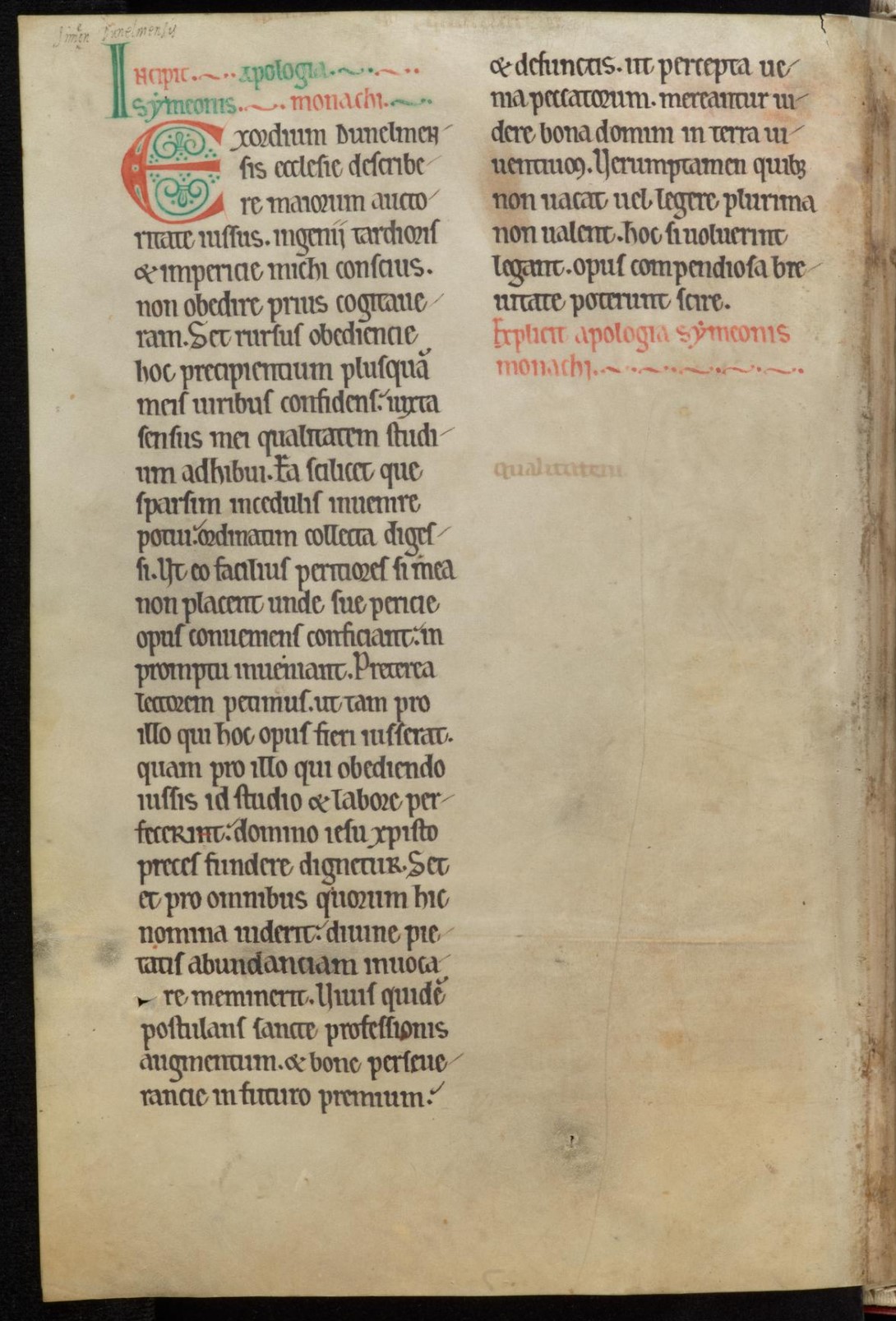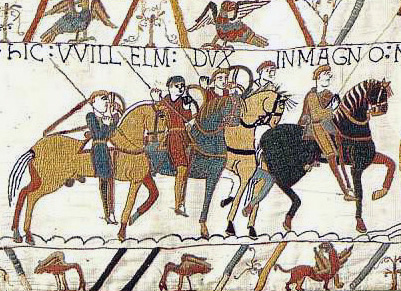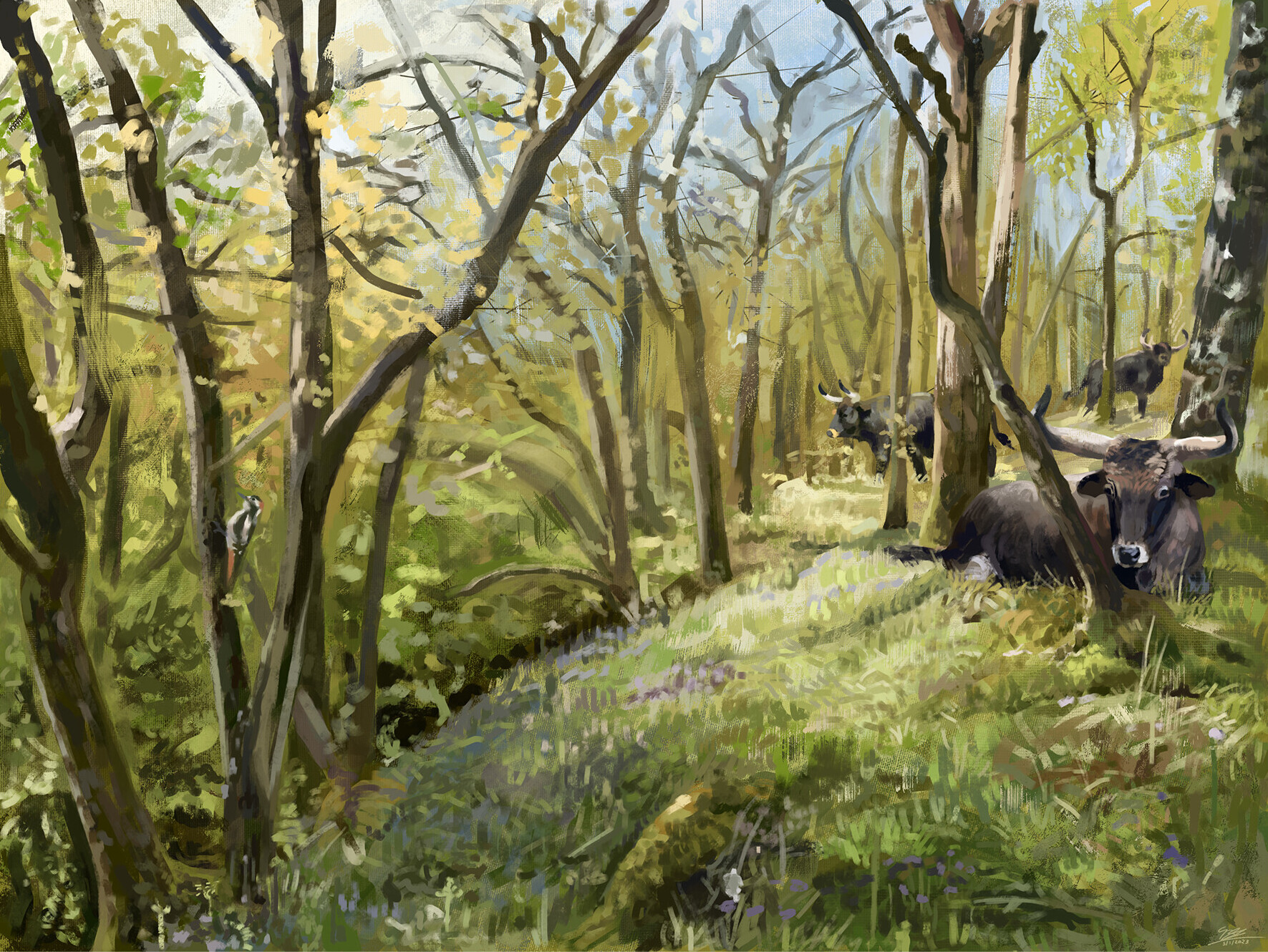|
Dun Cow
The Dun Cow is a common Motif (folkloristics), motif in English folklore. "Dun" is a dull shade of brownish grey. Dunsmore Heath The Dun Cow was said to be a savage beast roaming Dunsmore Heath, an area west of Dunchurch, near Rugby, Warwickshire, Rugby in Warwickshire, which was reputedly slain by Guy of Warwick. A large narwhal tusk is still exhibited at Warwick Castle as one of the ribs of the Dun Cow. The fable held that the cow belonged to a giant (mythology), giant, and was kept on Mitchell's Fold (middle fold), Shropshire. Its milk was inexhaustible; but one day an old witch who had filled her pail, wanted to fill her Riddle (tool), riddle (sieve) as well. This so enraged the animal that she broke loose from the fold and wandered to Dunsmore Heath, where she was slain by Guy of Warwick. Isaac Taylor (canon), Isaac Taylor, in his ''Words and Places'' (p. 269), says the dun cow is a corruption of the ''Dena Gau'' (Denmark, Danish region) in the neighbourhood of Warwick ... [...More Info...] [...Related Items...] OR: [Wikipedia] [Google] [Baidu] [Amazon] |
Motif (folkloristics)
The ''Motif-Index of Folk-Literature'' is a six volume catalogue of Motif (narrative), motifs, granular elements of folklore, composed by American folklorist Stith Thompson (1932–1936, revised and expanded 1955–1958). Often referred to as Thompson's motif-index, the catalogue has been extensively used in folklore studies, where folklorists commonly use it in tandem with the Aarne–Thompson–Uther Index (ATU), an index used for folktale type analysis. As standard tools The motif-index and the ATU indices are regarded as standard tools in the study of folklore. For example, folklorist Mary Beth Stein said that, "Together with Thompson's six-volume ''Motif-Index of Folk-Literature'', with which it is cross-indexed, ''The Types of Folktale'' constitutes the most important reference work and research tool for comparative folk-tale analysis.” Alan Dundes, who was an outspoken critic, also said substantially the same thing, without confining the application to comparative stud ... [...More Info...] [...Related Items...] OR: [Wikipedia] [Google] [Baidu] [Amazon] |
Danes (tribe)
The Danes were a North Germanic peoples, North Germanic tribe inhabiting southern Scandinavia, including the area now comprising Denmark proper, northern and eastern England, and Skåneland, the Scanian provinces of modern-day southern Sweden, during the Nordic Iron Age and the Viking Age. They founded what became the Kingdom of Denmark. The Etymology of Denmark, name of their realm is believed to mean "Danish March", viz. "the marches, march of the Danes", in Old Norse, referring to their southern border zone between the Eider (river), Eider and Schlei rivers, known as the Danevirke. Origins The origin of the Danes remains undetermined, but several ancient historical documents and texts refer to them and archaeology has revealed and continues to reveal insights into their culture, cultural beliefs, beliefs organization and way of life. A 2025 study in ''Nature'' found genetic evidence of an influx of central European population after about 500 AD into the region later ruled by the ... [...More Info...] [...Related Items...] OR: [Wikipedia] [Google] [Baidu] [Amazon] |
Saint Cuthbert
Cuthbert of Lindisfarne () ( – 20 March 687) was a saint of the early Northumbrian church in the Celtic tradition. He was a monk, bishop and hermit, associated with the monasteries of Melrose and Lindisfarne in the Kingdom of Northumbria, today in northern England and southern Scotland. Both during his life and after his death, he became a popular medieval saint of Northern England, with a cult centred on his tomb at Durham Cathedral. Cuthbert is regarded as the patron saint of Northumbria. His feast days are 20 March (Catholic Church, Church of England, Eastern Orthodox Church, Episcopal Church) and 4 September (Church in Wales, Catholic Church). Cuthbert grew up in or around Lauderdale, near Old Melrose Abbey, a daughter-house of Lindisfarne, today in Scotland. He decided to become a monk after seeing a vision on the night in 651 that Aidan, the founder of Lindisfarne, died, but he seems to have experienced some period of military service beforehand. He was made gue ... [...More Info...] [...Related Items...] OR: [Wikipedia] [Google] [Baidu] [Amazon] |
Libellus De Exordio Atque Procurso Istius, Hoc Est Dunhelmensis
The ''Libellus de exordio atque procursu istius, hoc est Dunhelmensis, ecclesie'' (), in short ''Libellus de exordio'', is a historical work of marked literary character composed and compiled in the early 12th-century and traditionally attributed to Symeon of Durham. It relates the history of bishopric and church of Durham and its predecessors at Lindisfarne and Chester-le-Street (''Cunecacestre''). It is sometimes also known as the ''Historia Dunelmensis ecclesiae'' (English: ''History of the Church of Durham''). Manuscripts The following is a list of manuscripts containing the text. Each manuscript has its own history, and contains different interpolations and notes. In brackets is the letter or letters used by Rollason, its latest editor, to refer to the manuscript in shorthand: * ''Durham, University Library, Cosin V.II.6'', (C) * ''London, British Library, Cotton Faustina A.V'', (F) * '' Cambridge University Library, Ff. i.27'', (Ca) * ''Durham, Durham Cathedral Library, A ... [...More Info...] [...Related Items...] OR: [Wikipedia] [Google] [Baidu] [Amazon] |
Symeon Of Durham
__NOTOC__ Symeon (or Simeon) of Durham (fl. c.1090 to c. 1128 ) was an English chronicler and a monk of Durham Priory. Biography Symeon was a Benedictine monk at Durham Cathedral at the end of the eleventh century. He may have been one of 23 monks moved to Durham from the monastery at Jarrow by Bishop William of St Calais in 1083, but the historian Bernard Meehan thinks that it is more likely that Symeon entered Durham in the 1090s. He eventually became precentor of the priory, and examples of his handwriting appear to survive in several Durham books, including the '' Liber Vitae'', the so-called Cantor's Book (whose text he would have had to keep up to date as part of his duties as precentor), and in copies of his own historical works. Works Symeon was author of two historical works which are particularly valuable for northern affairs, the '' Libellus de Exordio atque Procursu istius, hoc est Dunelmensis, Ecclesie'' (''The Little Book on the Origins and Progress of this Chu ... [...More Info...] [...Related Items...] OR: [Wikipedia] [Google] [Baidu] [Amazon] |
Durham, England
Durham ( , locally ) is a cathedral city and civil parish in the county of County Durham, Durham, England. It is the county town and contains the headquarters of Durham County Council, the unitary authority which governs the district of County Durham (district), County Durham. The built-up area had a population of 50,510 at the 2021 Census. The city was built on a meander of the River Wear, which surrounds the centre on three sides and creates a narrow neck on the fourth. The surrounding land is hilly, except along the Wear's floodplain to the north and southeast. Durham was founded in 995 by Anglo-Saxon monks seeking a place safe from Viking Age, Viking raids to house the relics of St Cuthbert. The church the monks built lasted only a century, as it was replaced by the present Durham Cathedral after the Norman Conquest; together with Durham Castle it is a UNESCO World Heritage Site. From the 1070s until 1836 the city was part of the County Palatine of Durham, a semi-independ ... [...More Info...] [...Related Items...] OR: [Wikipedia] [Google] [Baidu] [Amazon] |
UK Durham Dun-Cow
The United Kingdom of Great Britain and Northern Ireland, commonly known as the United Kingdom (UK) or Britain, is a country in Northwestern Europe, off the coast of the continental mainland. It comprises England, Scotland, Wales and Northern Ireland. The UK includes the island of Great Britain, the north-eastern part of the island of Ireland, and most of the smaller islands within the British Isles, covering . Northern Ireland shares a land border with the Republic of Ireland; otherwise, the UK is surrounded by the Atlantic Ocean, the North Sea, the English Channel, the Celtic Sea and the Irish Sea. It maintains sovereignty over the British Overseas Territories, which are located across various oceans and seas globally. The UK had an estimated population of over 68.2 million people in 2023. The capital and largest city of both England and the UK is London. The cities of Edinburgh, Cardiff and Belfast are the national capitals of Scotland, Wales and Northern Ireland. ... [...More Info...] [...Related Items...] OR: [Wikipedia] [Google] [Baidu] [Amazon] |
Aurochs
The aurochs (''Bos primigenius''; or ; pl.: aurochs or aurochsen) is an extinct species of Bovini, bovine, considered to be the wild ancestor of modern domestic cattle. With a shoulder height of up to in bulls and in cows, it was one of the largest herbivores in the Holocene; it had massive elongated and broad horns that reached in length. The aurochs was part of the Pleistocene megafauna. It probably evolved in Asia and migrated west and north during warm interglacial periods. The oldest-known aurochs fossils date to the Middle Pleistocene. The species had an expansive range spanning from Western Europe and North Africa to the Indian subcontinent and East Asia. The distribution of the aurochs progressively contracted during the Holocene due to habitat loss and hunting, with the last known individual dying in the Jaktorów forest in Poland in 1627. There is a long history of interaction between aurochs and humans, including archaic hominins like Neanderthals. The aurochs ... [...More Info...] [...Related Items...] OR: [Wikipedia] [Google] [Baidu] [Amazon] |
Bronze Age
The Bronze Age () was a historical period characterised principally by the use of bronze tools and the development of complex urban societies, as well as the adoption of writing in some areas. The Bronze Age is the middle principal period of the three-age system, following the Stone Age and preceding the Iron Age. Conceived as a global era, the Bronze Age follows the Neolithic, with a transition period between the two known as the Chalcolithic. The final decades of the Bronze Age in the Mediterranean basin are often characterised as a period of widespread societal collapse known as the Late Bronze Age collapse (), although its severity and scope are debated among scholars. An ancient civilisation is deemed to be part of the Bronze Age if it either produced bronze by smelting its own copper and alloying it with tin, arsenic, or other metals, or traded other items for bronze from producing areas elsewhere. Bronze Age cultures were the first to History of writing, develop writin ... [...More Info...] [...Related Items...] OR: [Wikipedia] [Google] [Baidu] [Amazon] |
Parlick
Parlick (also known as Parlick Pike) is an approximately cone-shaped steep-sided hill at the extreme south of the main range of Bowland fells in Lancashire, England. It has an elevation of above sea level. Origin of the name Regarding the origin of the name, Professor Eilert Ekwall, in his 1922 ''The Place-names of Lancashire'', writes: :".. (caput de) Pirloc 1228 C1R, Perlak 1228 WhC 371, Pireloke 1338 LPR, Pyrelok pyke c 1350 ib. The name cannot mean "pear orchard" as Wyld suggests. But the etymology may be correct with a slight amendment. O.E. ''loc'' means "fold for sheep or goats." A sheep fold at which grew a peartree (O.E. ''pyrige'') may very well have been at the foot of or on the slope of the hill; this may have been called Parlick (Pirloc) and have given the hill its name. For a probable earlier name see under Core, p. 143." Recreation Parlick has an elevation of above sea level and a prominence of about . The bog-free sides of Parlick make it more popular wit ... [...More Info...] [...Related Items...] OR: [Wikipedia] [Google] [Baidu] [Amazon] |
Grimsargh
Grimsargh is a village and civil parish in the City of Preston, Lancashire, England. It's located approximately east of Preston. History The name Grimsargh is said to derive from an Old Norse name ''Grímr'' with Norse ''erg''. One reference lists it as coming from the Domesday Book's ''Grimesarge'', "at the temple of Grimr" (a name for Odin). Oliver Cromwell's Roundhead army came through Grimsargh en route to what is now Walton-le-Dale in Preston, on what became known as the Battle of Preston on 17 August 1648. In 1868 by E. G. Paley was contracted to rebuild the nave and added a tower to an existing chapel in the village. Known today as St Michael's Church it is in sandstone with slate roofs, and consists of a nave, a north aisle, a chancel, a northeast vestry, and a west tower. The tower is in three stages, and has a southeast stair turret, angle buttresses, an embattled parapet, and a pyramidal roof. The parish was formed on 1 April 1934 from the merger of the pari ... [...More Info...] [...Related Items...] OR: [Wikipedia] [Google] [Baidu] [Amazon] |
Black Death
The Black Death was a bubonic plague pandemic that occurred in Europe from 1346 to 1353. It was one of the list of epidemics, most fatal pandemics in human history; as many as people perished, perhaps 50% of Europe's 14th century population. The disease is caused by the Bacteria, bacterium ''Yersinia pestis'' and spread by Flea, fleas and through the air. One of the most significant events in European history, the Black Death had far-reaching population, economic, and cultural impacts. It was the beginning of the second plague pandemic. The plague created religious, social and economic upheavals, with profound effects on the course of European history. The origin of the Black Death is disputed. Genetic analysis suggests ''Yersinia pestis'' bacteria evolved approximately 7,000 years ago, at the beginning of the Neolithic, with flea-mediated strains emerging around 3,800 years ago during the late Bronze Age. The immediate territorial origins of the Black Death and its outbreak ... [...More Info...] [...Related Items...] OR: [Wikipedia] [Google] [Baidu] [Amazon] |









